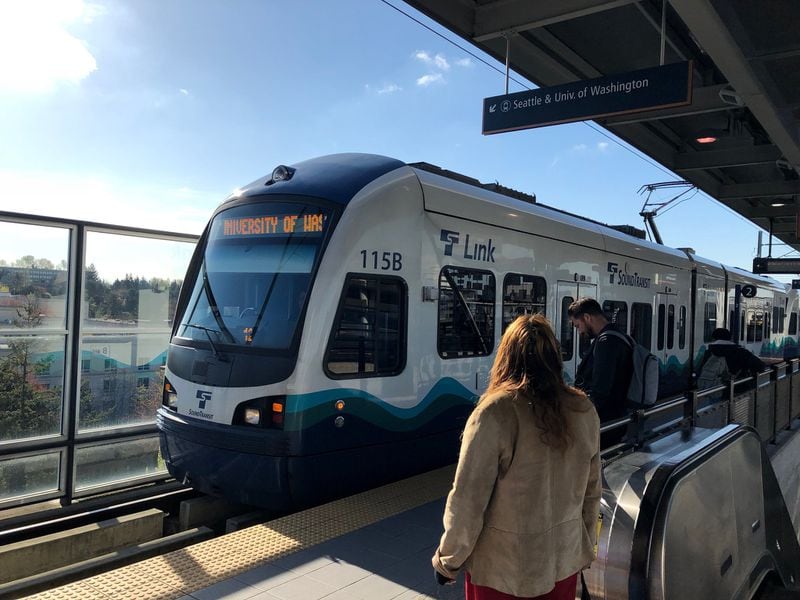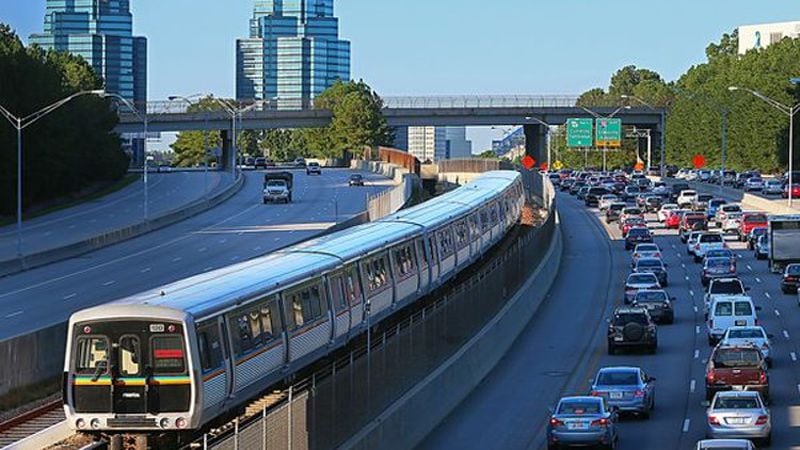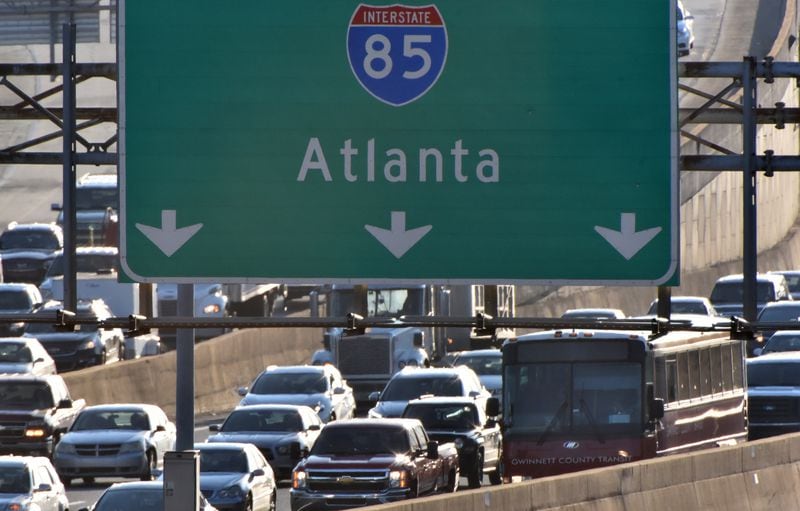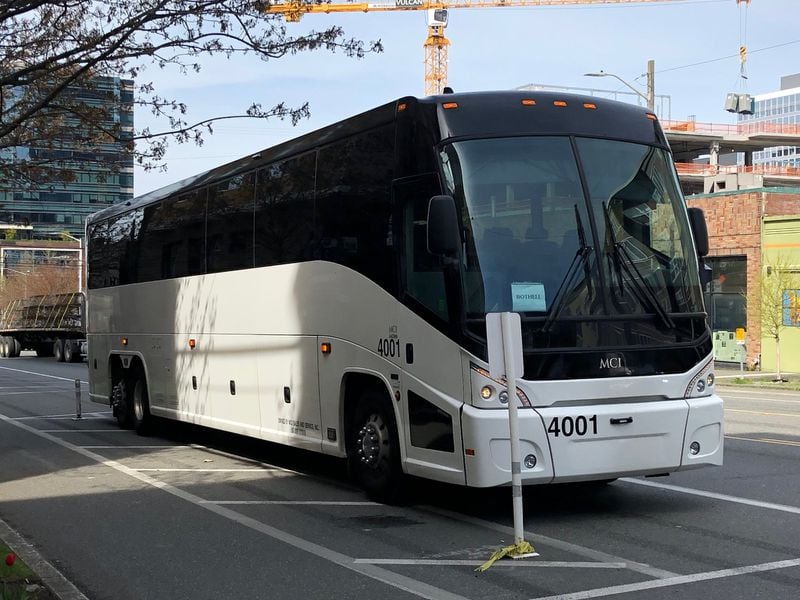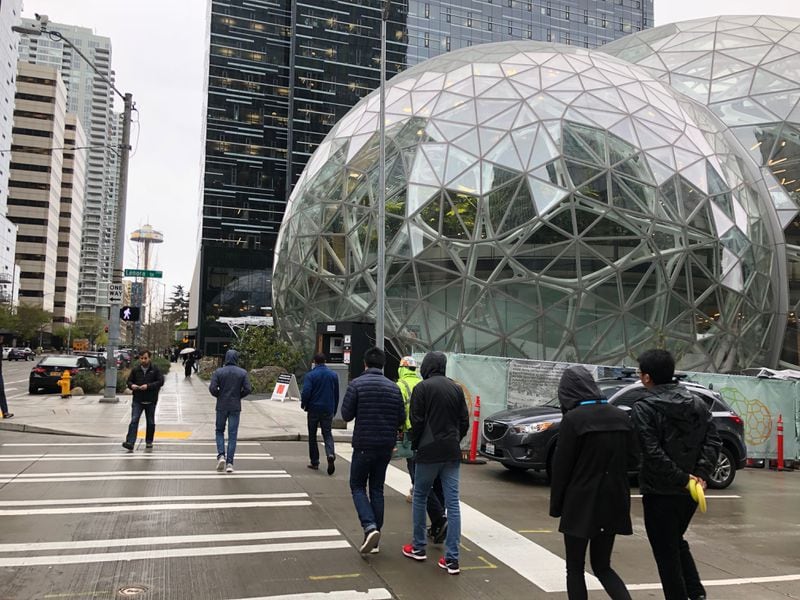SEATTLE — Felix Gudino spends hours behind the wheel each day, and traffic, he said, has gotten worse in the past few years as Amazon gobbled up more and more downtown real estate.
Gudino is an Uber driver, and the crush of tech workers downtown has been good for business, but a pain for fellow motorists. Vexed by some of the worst traffic in America, Seattle has a $54 billion transit expansion package underway, but it’ll take years before new rail lines will help relieve Seattle’s congestion.
"Seattle wasn't ready for them," Gudino said of Amazon and the region's tech boom.
Mobility is a significant issue in Seattle, and Amazon made transit a priority in its hunt for a second headquarters location, where it plans to locate 50,000 workers. But congested roads might be metro Atlanta's biggest liability in its bid for HQ2.
Amazon observers say the company will likely seek a site with strong transit links in a city with a broader transit network than Seattle’s.
Though Atlanta rates highly for airport connectivity, an educated workforce, quality of life, diversity and business climate, the region will have to shake its reputation for miserable congestion.
The state of Georgia lagged peer states on infrastructure spending for years. Metro Atlanta has limited heavy rail service compared to the breadth of the region and hasn’t extended its heavy rail network for nearly 20 years, despite adding nearly 2 million residents since 2000.
Atlanta ranked fourth-worst in the U.S. for traffic congestion by transportation firm INRIX, and only New York and Los Angeles were worse among the Amazon shortlist cities. Other HQ2 contenders Miami, Washington, Boston and Chicago also ranked worse for congestion than Seattle.
Metro Atlanta boosters acknowledge the region’s traffic woes, but point to recent initiatives that show the Atlanta area is getting serious about tackling them. New transit expansion plans are in progress and the change in the state’s gas tax a few years ago is pumping about $1 billion per year into roads and bridges.
The state’s secret bid for Amazon is said to include more than $1 billion in incentives, including tax breaks, grants, future transportation improvements and workforce initiatives.
Metro Atlanta has taken three critical steps to expand transit in recent years. Clayton County joined MARTA; Atlanta voters in 2016 approved a sales tax increase that could produce $2.5 billion for bus and rail expansion in the city limits; and state lawmakers approved this year a bill that would let counties vote to join a super-regional transit system.
In recent weeks, MARTA unveiled plans to add more than 20 miles of new rail and 18 miles of bus rapid transit routes in Atlanta, but the actual plan will be fleshed out in the months ahead.
MARTA is the ninth-largest U.S. transit system by ridership, according to the American Public Transportation Association. MARTA and the systems that serve metro Seattle carry a similar number of riders per day, though MARTA has more miles of rapid rail track.
Corporations are increasingly putting transit access high on their list of site selection criteria to provide workers with commute options and to appeal to younger workers who might prefer living in cities and using transit and ride-hailing services to get around.
Pat Wilson, the state’s commissioner of economic development, said efforts to expand transit will make the Atlanta region more competitive and help employers access talent. He credited local leaders, the Legislature and Gov. Nathan Deal for advancing transit.
“As long as we are having a big transit discussion for metro Atlanta, that’s a positive for economic development in the state,” he said.
But there’s fear the pending transit and highway investments won’t keep pace with future demand not only from Amazon, but from the projected 2.5 million new residents expected to move to the region by 2040.
Bill Jones lives near Piedmont Park and commutes to a job near the airport. He said it used to be a reverse commute with light traffic. But he finds roads around his home and the Downtown Connector are jammed more often amid the city’s latest development boom.
Jones likes MARTA, but he said it’s not a viable option because it would more than double his daily commute time compared to driving his car.
“Traffic will just be worse. If they do come, God help us all,” he said.
An urban boom
Since 2010, downtown Seattle has added about 60,000 jobs — mostly from Amazon, according to the Downtown Seattle Association.
Amazon occupies more than 8 million square feet of office space in more than three dozen buildings in downtown and the South Lake Union neighborhoods of the city.
The campus helped remake a former warehouse district into a hub of tech companies, including Facebook and a future campus for Google. Expedia is building a new headquarters nearby.
Like Atlanta, Seattle has been a slow adopter of rail.
Tell someone in Seattle that you are from Atlanta, and they'll likely mention Atlanta's rail network was supposed to be Seattle's. Atlanta won federal funds in the 1970s for rail when Atlantans approved local tax funding that Seattle residents wouldn't.
The Seattle region has a robust bus network, a commuter rail system called Sounder and a single light rail line that connects the University of Washington and downtown Seattle to the Seattle-Tacoma International Airport area.
In 2016, Seattle voters approved one of the nation’s largest transit expansion plans, including more than 60 miles of new light rail service that will crisscross Seattle’s downtown and stretch into the suburbs.
Amazon says more than half of its workers in Seattle walk, bike or take transit to work. Amazon also operates a fleet of unmarked white buses to help its workers commute to the suburbs.
Jon Scholes, CEO of the Downtown Seattle Association, said the city is trying to make up for years of inaction on transit. Amazon likes to hire young tech workers and many will want to live close to mass transit.
“The folks who work there don’t want to be in a car for an hour-and-a-half,” he said.
Gudino lives in Poulsbo, a suburb about 22 miles west of Seattle on the opposite side of Puget Sound. Each morning, he drives his Toyota Prius aboard a ferry for a 30-minute ride across the water.
“It’s busy enough that it’s worth it,” he said.
But the tech growth in Seattle’s city center has caused housing prices to soar, forcing out longtime residents. The city has grown denser, but transportation infrastructure hasn’t kept pace with development, exacerbating the traffic problem, Gudino said.
‘Choosing to invest in transit’
Locations along MARTA’s heavy rail lines likely make the most sense for HQ2.
Amazon visited Atlanta at the end of March, and people familiar with the visit said the company examined several locations served by MARTA rail, including south downtown, the Gulch and sites in Midtown.
In its request for proposals, Amazon listed a desire for transit and highway access and sites with ready land for development. The company’s aggressive timeline suggests it also needs existing office space that’s move-in ready.
“There are not too many places in metro Atlanta that have the combination of heavy rail and that much office space they could occupy immediately,” said MARTA Chairman Robbie Ashe.
Some of metro Atlanta’s biggest jobs wins since the recession have come near MARTA stations, including expansions by NCR, Honeywell and Kaiser Permanente. The hunt for HQ2 and other big corporate projects is forcing Atlanta’s suburbs to consider transit expansion to remain competitive.
The new transit bill provides a path for other counties to join a regional system and to raise sales taxes to fund new investments. Atlanta and Clayton are the two jurisdictions that recently passed referenda to tax themselves, but Ashe said they won’t be the last.
“I expect that situation to change over the next year or two with more communities choosing to invest in transit,” he said.
Chasing Amazon HQ2
The Atlanta Journal-Constitution has closely followed the hunt for Amazon HQ2, bringing readers details of the state’s bid, evaluating the field of finalists and covering the issues that could come with such a mammoth headquarters. Today, the AJC brings you a report on how transit will likely play a key role in Amazon’s choice of city for HQ2.
10 most congested cities in the U.S.
Los Angeles*
New York**
San Francisco
Atlanta*
Miami*
Washington**
Boston*
Chicago*
Seattle
Dallas*
*-Denotes a finalist community for Amazon HQ2.
**-Greater New York and Washington, D.C., have multiple finalsts within the respective metro areas.
Source: Inrix
